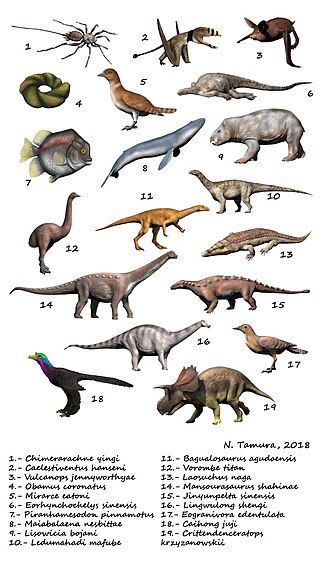
Spiropreussiones are bio-active Preussia isolates.

Spiropreussiones are bio-active Preussia isolates.

Diprotodon is an extinct genus of marsupial from the Pleistocene of Australia containing one species, D. optatum. The earliest finds date to 1.77 million to 780,000 years ago but most specimens are dated to after 110,000 years ago. Its remains were first unearthed in 1830 in Wellington Caves, New South Wales, and contemporaneous paleontologists guessed they belonged to rhinos, elephants, hippos or dugongs. Diprotodon was formally described by English naturalist Richard Owen in 1838, and was the first named Australian fossil mammal, and led Owen to become the foremost authority of his time on other marsupials and Australian megafauna, which were enigmatic to European science.

An endosymbiont or endobiont is any organism that lives within the body or cells of another organism most often, though not always, in a mutualistic relationship. (The term endosymbiosis is from the Greek: ἔνδον endon "within", σύν syn "together" and βίωσις biosis "living".) Examples are nitrogen-fixing bacteria, which live in the root nodules of legumes, single-cell algae inside reef-building corals and bacterial endosymbionts that provide essential nutrients to insects.

In zoology, megafauna are large animals. The most common thresholds to be a megafauna are weighing over 46 kilograms (100 lb) or weighing over a tonne, 1,000 kilograms (2,205 lb). The first of these include many species not popularly thought of as overly large, and being the only few large animals left in a given range/area, such as white-tailed deer, Thomson's gazelle, and red kangaroo. In practice, the most common usage encountered in academic and popular writing describes land mammals roughly larger than a human that are not (solely) domesticated. The term is especially associated with the Pleistocene megafauna – the land animals often larger than their extant counterparts that are considered archetypical of the last ice age, such as mammoths, the majority of which in northern Eurasia and the Americas became extinct within the last forty thousand years. Among living animals, the term megafauna is most commonly used for the largest extant terrestrial mammals, which includes elephants, giraffes, hippopotamuses, rhinoceroses, and large bovines. Of these five categories of large herbivores, only bovines are presently found outside of Africa and southern Asia, but all the others were formerly more wide-ranging, with their ranges and populations continually shrinking and decreasing over time. Wild equines are another example of megafauna, but their current ranges are largely restricted to the Old World, specifically Africa and Asia. Megafaunal species may be categorized according to their dietary type: megaherbivores, megacarnivores, and, more rarely, megaomnivores. The megafauna is also categorized by the class of animals that it belongs to, which are mammals, birds, reptiles, amphibians, fish, and invertebrates.

The term Australian megafauna refers to the megafauna in Australia during the Pleistocene Epoch. Most of these species became extinct during the latter half of the Pleistocene, and the roles of human and climatic factors in their extinction are contested.
Preussia can refer to:
P. polymorpha may refer to:

Paleontology or palaeontology is the study of prehistoric life forms on Earth through the examination of plant and animal fossils. This includes the study of body fossils, tracks (ichnites), burrows, cast-off parts, fossilised feces (coprolites), palynomorphs and chemical residues. Because humans have encountered fossils for millennia, paleontology has a long history both before and after becoming formalized as a science. This article records significant discoveries and events related to paleontology that occurred or were published in the year 2018.

Falkensteen is a manor house located five kilometres south of Slagelse, Denmark. The current Neoclassical main building was built for Georg Frederik Ditlev Koës in 1775. It was listed on the Danish registry of protected buildings and places in 1950. A half-timbered barn from 1864 is also listed.